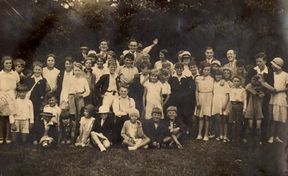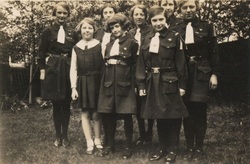A History of WHBC
 (Sunday School Outing 1933)
(Sunday School Outing 1933)
The nucleus of the new church was made up of eighteen members from Bethnal Green plus a small group of Baptists who had been worshipping locally in a private house. However the work grew apace and by 1912 the membership had risen to a hundred and sixty seven. There were also a hundred and twelve children in the Primary department of the Sunday School who were spilling out of the space available. There was a great proliferation of organisations, not all of which lasted very long, but worth a mention. These included Young Men’s and Women’s Bible classes, a Band of Hope and a Literary Society in 1910, and a Brotherhood with a hundred members and a Women’s Own with over a hundred members in 1911. At some time there were also a Tennis Club, a Cycling Club, and a League of Ropeholders (a children’s organisation). In 1922 the Baptist Women’s League was formed, which continued for a great many years, finally amalgamating with the Women’s Own about 1978.
Although the First World War soon shed a shadow on the scene, the church members worked hard to purchase and furnish houses for the use of Belgian refugees. By the end of the war, membership had risen to two hundred and ten. There were various changes of minister during these years, but in 1924 a very well loved man came to the pastorate. His name was Revd Charles Vick, an experienced leader who led the church into a period of stability, and although he had to resign in 1929 through illness, he had achieved much during this time, an important part of which was to erect a hall at the back of the premises to house the burgeoning youth work and Sunday School. He named it Carey Hall, and it has continued to provide a service the church just could not do without.
Although the First World War soon shed a shadow on the scene, the church members worked hard to purchase and furnish houses for the use of Belgian refugees. By the end of the war, membership had risen to two hundred and ten. There were various changes of minister during these years, but in 1924 a very well loved man came to the pastorate. His name was Revd Charles Vick, an experienced leader who led the church into a period of stability, and although he had to resign in 1929 through illness, he had achieved much during this time, an important part of which was to erect a hall at the back of the premises to house the burgeoning youth work and Sunday School. He named it Carey Hall, and it has continued to provide a service the church just could not do without.
 (‘Skylarks’ patrol 1933 (guides))
(‘Skylarks’ patrol 1933 (guides))
The church has always put young people at the heart of its work. In 1921 a Girl Guide company was started, followed by a Brownie pack in 1925. These continued with great success for fifty years. A Boy’s Club was also begun in 1923, but when in 1924 the Boy’s Brigade became another new venture for the church, followed by a Junior Section the following year, the Boy’s club was disbanded and the boys were assimilated into the Brigades. The Boy’s Brigade is still a very important part of the fellowship today. In 1933 the Guild of Young People began, and was the ultimate meeting place for young people over the age of sixteen. It was known as the ‘GYPs’, and it continued for many years until, with other organisations springing up, and its membership depleting, it finally closed in 1957.
